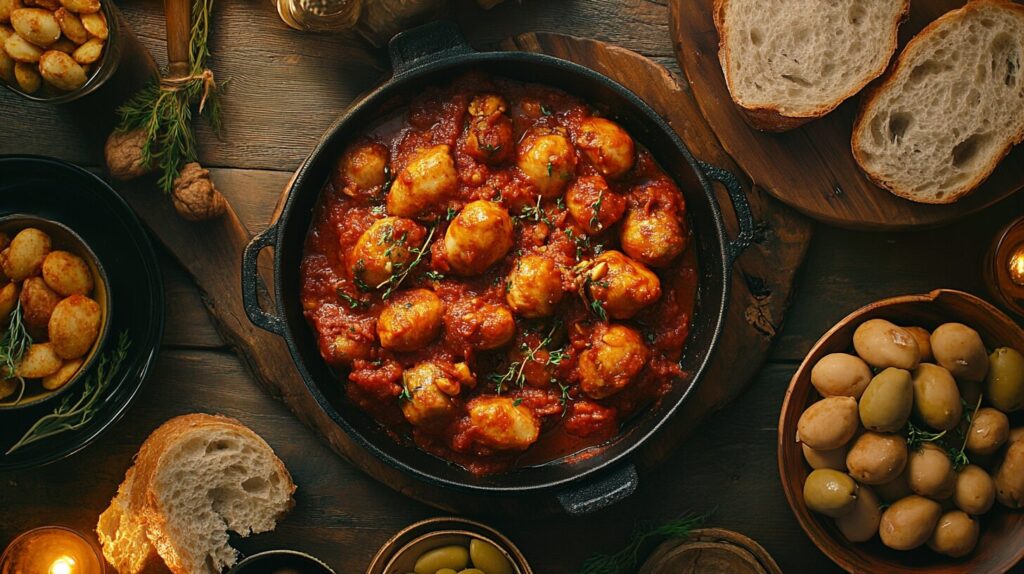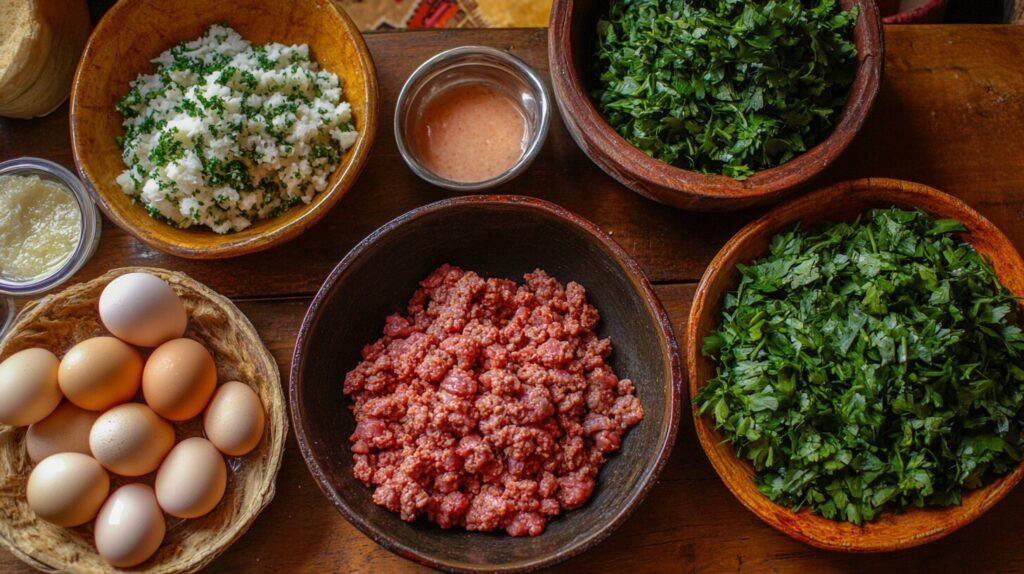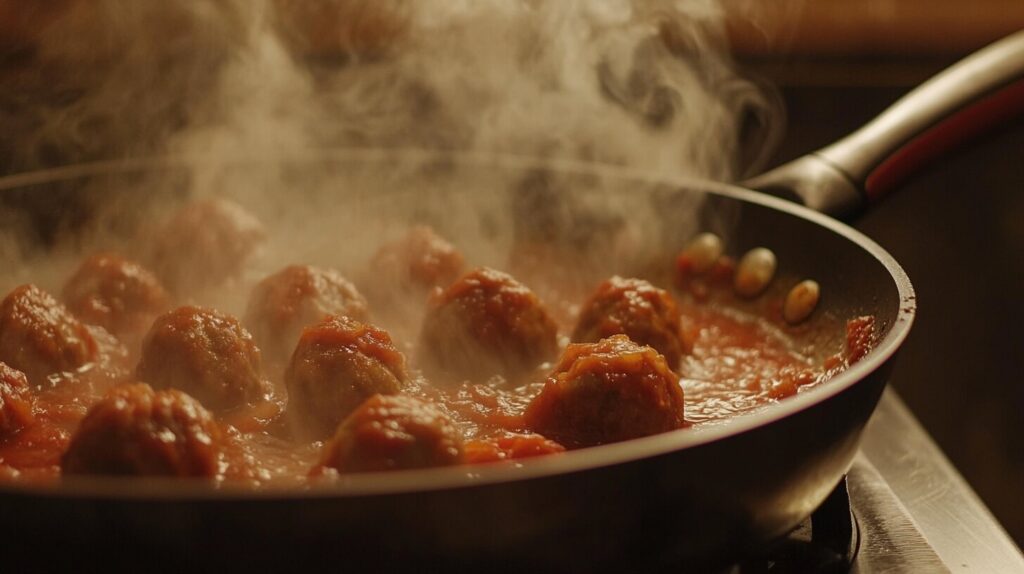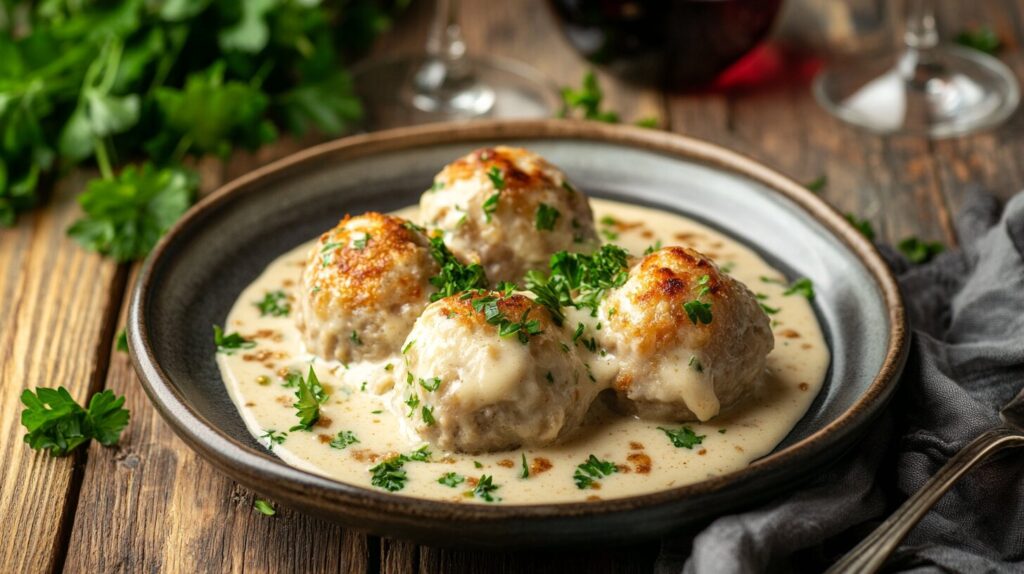
If you’ve ever visited a bustling Spanish tapas bar or enjoyed a homemade meal in Spain, you’ve probably encountered Albóndigas — the flavorful and juicy Spanish meatballs loved by many. But what exactly goes into making these meatballs? From the blend of meats to the aromatic herbs and sauces, Albóndigas are a true culinary delight.
In this guide, we’ll explore everything about Spanish meatballs: their history, traditional ingredients, regional variations, and tips for making them at home. So, if you’ve ever wondered, “What are Spanish meatballs made of?” you’re in the right place.
Albóndigas are more than just a dish. They represent a piece of Spain’s culture, tradition, and warmth. Each bite tells a story of heritage and flavor. Ready to learn more? Let’s dive in! 🇪🇸
Table of Contents
The Rich History of Spanish Meatballs
Every culture has its own version of meatballs, and Albóndigas have a history as rich and savory as the dish itself. The roots of Spanish meatballs date back to the Moorish influence in Spain during the Middle Ages. The word Albóndigas comes from the Arabic term “al-bunduq,” which means hazelnut or little round ball — a nod to their shape.
A Blend of Cultures
The Moors brought their love of seasoned meatballs to Spain. They used spices like cumin, saffron, and coriander. Over time, Spanish cooks adapted these recipes by adding local flavors and cooking methods. As a result, Albóndigas became a staple in Spanish homes, passed down through generations.
From Tapas to Main Dishes
Originally, people served Albóndigas as part of tapas — small appetizers meant for sharing. However, they’ve evolved into a hearty main dish, often paired with tomato sauce or savory broth. Each region in Spain adds its own twist, reflecting the country’s diversity.
📝 “Albóndigas are more than food — they’re a symbol of Spain’s rich history and love for flavorful dishes.”
Traditional Ingredients for Spanish Meatballs
Authentic Spanish meatballs use a few classic ingredients that create their signature taste. Let’s look at what makes Albóndigas so delicious.

Types of Meat Used in Albóndigas
The main ingredient in Albóndigas is the meat. Traditional recipes usually mix beef and pork, which gives a balanced flavor and tender texture. Here’s a breakdown:
- Beef: It provides a hearty, meaty taste.
- Pork: This meat adds juiciness, keeping the meatballs moist.
In some regions, people use lamb, especially where it’s more common. Lamb adds a richer, slightly gamey flavor that works well with spices.
Alternative Meats: For a lighter option, you can use chicken or turkey. These meats are leaner but still flavorful if seasoned well.
Herbs and Spices That Define the Flavor
No Spanish meatball is complete without a mix of herbs and spices. These ingredients give Albóndigas their distinctive aroma and depth. Popular seasonings include:
- Parsley: Adds a fresh, slightly peppery flavor.
- Garlic: A staple in Spanish cooking, garlic brings bold and aromatic notes.
- Paprika: Offers a hint of smokiness and bright color.
- Cumin: This earthy spice reflects the Moorish influence.
- Black Pepper: Provides a bit of heat and complexity.
The Role of Bread, Eggs, and Binding Agents
To achieve the perfect texture, Albóndigas rely on a few key binding agents:
- Bread: Traditionally, people soak stale bread in milk to keep the meatballs soft.
- Eggs: They help bind the ingredients, so the meatballs stay intact while cooking.
- Breadcrumbs: These offer structure and firmness to the mixture.
This combination ensures the meatballs are neither too dense nor too crumbly.
🍽️ “A good Albóndiga balances meat, herbs, and binders perfectly.”
Common Variations of Albóndigas Across Spain
Spain’s diverse regions offer unique takes on Albóndigas. Each area adds its twist, reflecting local ingredients and cooking styles. Here are some popular variations you might come across.
Andalusian Albóndigas: A Regional Twist
In Andalusia, people often serve Albóndigas with a creamy “salsa de almendras” (almond sauce). This sauce adds a rich, nutty flavor that sets it apart.
Ingredients for Almond Sauce:
- Ground almonds
- Garlic
- Saffron
- Bread (to thicken the sauce)
- Olive oil
The use of almonds highlights the region’s Moorish past. People enjoy these meatballs with rice or crusty bread.
Catalonian-Style Meatballs
In Catalonia, Albóndigas often feature a mix of beef and pork, seasoned with cinnamon and nutmeg for a hint of sweetness. They are typically served in a tomato-based sauce with peas or mushrooms.
This version reflects Catalonia’s love for blending sweet and savory flavors. It’s a unique and delicious twist on the classic meatball.
Albóndigas in Different Sauces
One of the best things about Albóndigas is their flexibility with sauces. Some popular choices include:
- Tomato Sauce: The classic choice, offering a rich and slightly sweet flavor.
- Saffron Broth: Light and fragrant, this broth adds subtle sophistication.
- Garlic and White Wine Sauce: Simple yet elegant, this sauce combines bold garlic with crisp white wine.
Each sauce gives the meatballs a unique taste experience.
How to Make Authentic Spanish Meatballs at Home
Making authentic Albóndigas at home is easier than you might think. The key to success lies in using the right ingredients, following the proper steps, and paying attention to the small details. Here, we’ll walk through a classic recipe and share some essential tips to ensure your meatballs turn out tender, flavorful, and perfectly cooked.
Step-by-Step Recipe for Classic Albóndigas
Here’s a simple yet delicious recipe for traditional Spanish meatballs. This recipe will give you about 20-24 meatballs — perfect for a family dinner or a tapas-style gathering.
Ingredients:
- For the Meatballs:
- 250g (½ pound) ground beef
- 250g (½ pound) ground pork
- 2 slices of stale bread, soaked in milk
- 2 cloves garlic, minced
- 1 large egg
- 1 tablespoon fresh parsley, chopped
- ½ teaspoon ground cumin
- ½ teaspoon smoked paprika
- Salt and black pepper to taste
- 2 tablespoons breadcrumbs (if needed for texture)
- For the Sauce:
- 2 tablespoons olive oil
- 1 onion, finely chopped
- 2 cloves garlic, minced
- 1 can (400g) crushed tomatoes
- 1 teaspoon smoked paprika
- 1 bay leaf
- ½ cup white wine
- 1 cup chicken or beef broth
- Salt and pepper to taste
Instructions:

- Prepare the Meatball Mixture:
- In a large mixing bowl, combine the ground beef, ground pork, minced garlic, soaked bread, egg, parsley, cumin, paprika, salt, and pepper.
- Mix gently with your hands until everything is just combined. Be careful not to overmix, as this can make the meatballs tough.
- Form the Meatballs:
- Roll the mixture into balls, about 1 inch in diameter. If the mixture is too sticky, add a bit of breadcrumbs to help bind it.
- Place the meatballs on a plate or tray, and let them rest in the refrigerator for at least 30 minutes. This helps them hold their shape during cooking.
- Cook the Meatballs:
- Heat 2 tablespoons of olive oil in a large pan over medium heat.
- Add the meatballs and brown them on all sides. This should take about 5-7 minutes. They don’t need to be fully cooked at this stage, just nicely browned.
- Remove the meatballs and set them aside.
- Make the Sauce:
- In the same pan, add the chopped onion and sauté until softened (about 5 minutes).
- Add the garlic and cook for another minute.
- Pour in the crushed tomatoes, smoked paprika, bay leaf, white wine, and broth. Stir to combine.
- Simmer the sauce for about 10 minutes to let the flavors meld together.
- Combine and Simmer:
- Return the meatballs to the pan, nestling them into the sauce.
- Cover and simmer for another 15-20 minutes, or until the meatballs are cooked through and the sauce has thickened slightly.
- Taste and adjust the seasoning with salt and pepper if needed.
- Serve and Enjoy:
- Garnish with fresh parsley and serve hot with crusty bread, rice, or potatoes.
🍽️ “Cooking Albóndigas is like capturing the heart of Spain on a plate — simple ingredients, bold flavors, and a touch of tradition.”
Tips for Achieving Perfect Texture and Flavor
To ensure your Albóndigas turn out just right, keep these tips in mind:
- Don’t Overmix: Gently combine the meat mixture to avoid making the meatballs dense.
- Use Fresh Herbs: Fresh parsley and garlic make a big difference in flavor.
- Chill the Meatballs: Letting the meatballs rest in the fridge before cooking helps them stay firm and hold their shape.
- Brown First, Simmer Later: Browning the meatballs before simmering adds depth and richness to the flavor.
- Taste the Sauce: Before adding the meatballs back to the pan, taste the sauce and adjust seasoning as needed.
By following these tips, you’ll get tender, juicy meatballs that burst with flavor.
Common Problems When Making Spanish Meatballs
Even seasoned cooks can run into issues when making meatballs. Let’s address some of the most common problems and how to solve them.
Why Do My Meatballs Fall Apart?
Meatballs can fall apart for several reasons:
- Not Enough Binding Agents: Eggs, soaked bread, or breadcrumbs help hold everything together. Make sure you’re using enough.
- Overhandling the Mixture: Mixing the meat too much can break down the proteins, making the mixture too loose. Combine gently until just mixed.
- Skipping the Chill Time: Letting the meatballs rest in the fridge helps them firm up. Aim for at least 30 minutes of chilling.
Solution: Add a bit more breadcrumbs or another egg, and always chill the meatballs before cooking.
How to Prevent Dry and Tough Meatballs
Dry meatballs can ruin an otherwise perfect meal. Here’s how to keep them juicy:
- Use a Mix of Meats: Combining pork with beef helps maintain moisture. Pork adds fat, which keeps the meatballs tender.
- Don’t Overcook: Simmer the meatballs gently in sauce rather than baking or frying them for too long.
- Soak the Bread: Using bread soaked in milk or broth adds moisture to the mixture.
Solution: Ensure you’re not overcooking, and always use a bit of fat in the mixture, like pork or even a splash of olive oil.
Fixing Overly Greasy Meatballs
Too much fat can lead to greasy meatballs. To fix this:
- Trim Excess Fat: If using pork, opt for a leaner cut.
- Drain After Browning: After frying, drain the meatballs on paper towels before adding them to the sauce.
Solution: Balance lean and fatty meats, and always let the meatballs rest on a paper towel to absorb extra grease.
💡 “Great meatballs are all about balance — not too dry, not too greasy, and full of flavor.”
Pairing Ideas for Spanish Meatballs
Albóndigas are versatile and pair well with a range of sides and drinks. Here are some ideas to elevate your meal.

Classic Tapas Pairings
Albóndigas are often part of a tapas spread. Consider pairing them with:
- Patatas Bravas: Crispy fried potatoes with a spicy tomato sauce.
- Pan con Tomate: Bread rubbed with tomato, garlic, and olive oil.
- Chorizo al Vino: Chorizo sausage cooked in red wine.
- Tortilla Española: A classic Spanish omelet with potatoes and onions.
These dishes complement the richness of the meatballs, creating a well-rounded tapas experience.
Best Wines to Serve with Albóndigas
The right wine can enhance the flavors of your Albóndigas. Here are some top choices:
- Tempranillo: This classic Spanish red wine pairs beautifully with the savory, spiced flavors of the meatballs.
- Garnacha (Grenache): A versatile red wine with berry notes that balance the richness of the dish.
- Albariño: If you prefer white wine, this crisp, slightly acidic option works well with meatballs in lighter sauces.
Tip: Serve the wine slightly chilled to highlight its flavors.
🍷 “A good wine pairing transforms Albóndigas into a culinary experience — like a little Spanish fiesta in your mouth!”
Health Benefits of Spanish Meatballs
While Albóndigas are known for their rich and savory flavor, they can also offer several health benefits when prepared thoughtfully. By choosing quality ingredients and cooking methods, you can enjoy this traditional dish without compromising on nutrition.
Nutritional Value Breakdown
Traditional Spanish meatballs provide a good balance of protein, fats, and essential vitamins and minerals. Let’s break down the nutritional value of a typical serving of Albóndigas (about 4-5 meatballs in sauce):
- Protein: The combination of beef and pork offers a high protein content, essential for muscle growth and repair. One serving of Albóndigas typically contains around 20-25 grams of protein.
- Healthy Fats: Pork provides fats that add moisture and flavor. When using leaner cuts or a mix of meats, you can balance fat content. Opt for olive oil in the sauce for heart-healthy fats.
- Vitamins and Minerals: Ingredients like garlic, onions, and parsley add a variety of vitamins (like vitamin C, B6, and K) and minerals (such as iron, zinc, and potassium).
- Fiber: If served with vegetables or whole-grain bread, Albóndigas can offer a decent amount of dietary fiber.
Calories per Serving
A serving of Albóndigas with sauce typically contains around 300-350 calories, depending on the ingredients and portion size. To keep the dish healthier, avoid frying the meatballs in excessive oil and serve them with light sides like salads or steamed vegetables.
How to Make Healthier Albóndigas
You don’t have to compromise flavor to make healthier Albóndigas. Here are some simple tweaks to make this dish more nutritious:
- Use Lean Meats: Substitute ground beef and pork with leaner options like ground turkey or chicken. These meats are lower in fat and calories but still delicious.
- Add Vegetables: Sneak in finely chopped vegetables like carrots, bell peppers, or spinach into the meatball mixture. This boosts fiber and nutrients.
- Bake Instead of Fry: Instead of frying the meatballs in oil, bake them in the oven at 400°F (200°C) for about 20 minutes. This reduces excess fat.
- Use Whole Wheat Breadcrumbs: Opt for whole wheat breadcrumbs instead of white bread for added fiber.
- Reduce Salt: Cut back on salt and rely more on herbs and spices for flavor.
🥦 “With a few healthy swaps, you can enjoy Albóndigas guilt-free and still savor all their traditional goodness.”
Explore More Spanish Culinary Delights 🇪🇸
If you loved diving into the world of Albóndigas, there’s so much more to explore! Discover the rich meaning and origins of these classic meatballs in our Albóndigas Meaning Guide. Want to know how to keep your Albóndigas fresh and delicious? Check out our Complete Storage Guide for Albóndigas. And if you’re looking to balance flavors with a healthier option, our guide on Rice Cake Benefits and Recipes has got you covered. Bring more Spanish tradition to your table and enjoy cooking like never before! ✨
Frequently Asked Questions About Spanish Meatballs
Curious about Albóndigas? Here are answers to some common questions about these beloved Spanish meatballs.
Can I Freeze Spanish Meatballs?
Yes, Albóndigas freeze very well! Here’s how to do it:
- Cook and Cool: Prepare the meatballs and sauce as usual. Allow them to cool completely.
- Store in Containers: Place the meatballs and sauce in airtight containers or freezer bags. Label them with the date.
- Freeze: They can be stored in the freezer for up to 3 months.
Reheating: Thaw overnight in the refrigerator and reheat in a pan over medium heat until warmed through. You can also reheat them directly from frozen — just allow for a longer cooking time.
Are Spanish Meatballs Gluten-Free?
Traditional Albóndigas contain bread or breadcrumbs, which usually have gluten. However, you can make them gluten-free by using these alternatives:
- Gluten-Free Breadcrumbs: Available at most grocery stores.
- Crushed Rice Cakes: A crunchy and gluten-free substitute.
- Almond Flour: Adds a nutty flavor and works well as a binder.
Always check that all other ingredients, like spices and broth, are gluten-free.
Can I Use Turkey or Chicken Instead of Beef or Pork?
Absolutely! Turkey or chicken makes a leaner and lighter version of Albóndigas. Here’s what to keep in mind:
- Flavor: Ground turkey or chicken has a milder flavor, so increase the herbs and spices to keep the dish flavorful.
- Moisture: Because these meats are leaner, add a bit of olive oil to the mixture to prevent dryness.
💡 “Using turkey or chicken is a great way to enjoy Albóndigas while keeping things light and healthy.”
Conclusion: Enjoying the Delicious Tradition of Albóndigas
Spanish meatballs, or Albóndigas, are more than just a dish — they’re a celebration of Spain’s rich culinary heritage. From their Moorish origins to their modern-day variations, these meatballs offer a delightful mix of flavors, history, and tradition.
Whether you enjoy them as part of a tapas spread, a hearty main course, or a healthy weeknight dinner, Albóndigas have something to offer everyone. By understanding the key ingredients, cooking methods, and regional variations, you can bring a piece of Spain into your own kitchen.
So, the next time you’re in the mood for something warm, flavorful, and comforting, give Albóndigas a try. With their versatility, rich flavors, and satisfying textures, these meatballs might just become your new favorite dish. ¡Buen provecho! 🇪🇸
